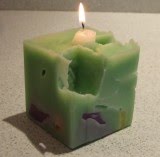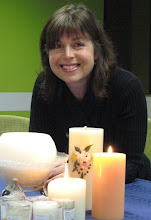
Here are some more tips.
Your questions help us identify areas that will interest other readers, so keep asking!
The photo shows a batch of glass candles being made, always make some tea lights at the same time.
- warm glass containers before pouring candles
- create channels when making pillars
- use palm wax, as is, for a fast effective designer candle in any glass or ceramic container - pour in the beads and add a waxed wick
- roll a beeswax candle for a perfect fit to your candle holder
- use a long needle to help with wicking tricky moulds - available at quilting shops
- when making container candles, pour the wax, wait for a minute till an outer layer forms, then sit the wick into the 'muddy' wax on the bottom - it will stand there happy as...
- it's hard to tell the colour of your wax when it's hot - take out a little with a teaspoon, put it into cold water and watch it change to the finished colour when cold. You can then alter the colour to make it exactly as you need it, keep testing till you're there.
- if you want a textured look, 'rustic', pour your wax at a lower temperature
- 10ml fragrance is generally recommended to go into 1kg wax. For container candles you can increase this amount, but it's a good start point.
- cracks in container soy? You need to change to C-Soy from www.candlemaking.com.au; it could be over-fragranced; poured too hot; poured too fast
- soy wax looks curdled? too much fragrance
- want a better scent throw? choose a fragrance with an inherently stronger scent; burn your candle a while then extinguish the flame and enjoy the scent from the melt pool
- boldest colours are achievable in paraffin, the most translucent of the wax
- pour palm into warm glass for a great patterned container candle
- beeswax won't burn - see earlier blog, it may need more washing and filtering
- TEST the burn time and quality before you sell your candle
- if your wax burn too quickly, reduce the size of the wick
- if the candle 'tunnels' it needs a larger wick, larger flame, more heat, larger melt pool
- watch a video before starting, it will help a great deal
- ask your supplier for help, there is always an easy solution! Our customers know we are there to help on 02 9653 3600
+3.jpg)












